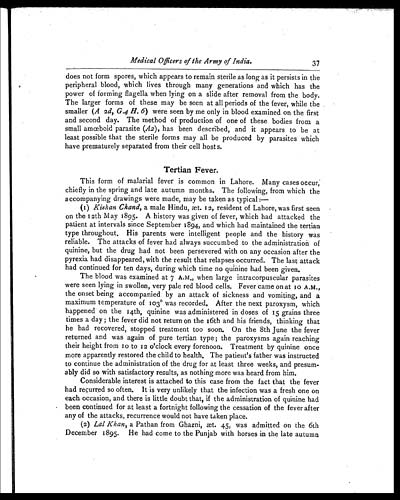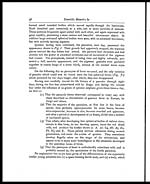Medicine - Institutions > Army health reports and medical documents > Scientific memoirs by medical officers of the Army of India > Part X, 1897 > 2 - Notes on the malarial parasite as observed in the blood during life, and in the tissues post-mortem, at Lahore, Punjab
(43) Page 37
Download files
Individual page:
Thumbnail gallery: Grid view | List view

Medical Officers of the Army of India.
37
does not form spores, which appears to remain sterile as long as it persists in the
peripheral blood, which lives through many generations and which has the
power of forming flagella when lying on a slide after removal from the body.
The larger forms of these may be seen at all periods of the fever, while the
smaller (A 2d, G.4 H. 6 ) were seen by me only in blood examined on the first
and second day. The method of production of one of these bodies from a
small amœboid parasite (A2 ), has been described, and it appears to be at
least possible that the sterile forms may all be produced by parasites which
have prematurely separated from their cell hosts.
Tertian Fever.
This form of malarial fever is common in Lahore. Many cases occur,
chiefly in the spring and late, autumn months. The following, from which the
accompanying drawings were made, may be taken as typical:—
(1) Kishan Chand, a male Hindu, æt. 12, resident of Lahore, was first seen
on the 12th May 1895. A history was given of fever, which had attacked the
patient at intervals since September 1894, and which had maintained the tertian
type throughout. His parents were intelligent people and the history was
reliable. The attacks of fever had always succumbed to the administration of
quinine, but the drug had not been persevered with on any occasion after the
pyrexia had disappeared, with the result that relapses occurred. The last attack
had continued for ten days, during which time no quinine had been given.
The blood was examined at 7 A.M., when large intracorpuscular parasites
were seen lying in swollen, very pale red blood cells. Fever came on at 10 A.M.,
the onset being accompanied by an attack of sickness and vomiting, and a
maximum temperature of 103° was recorded. After the next paroxysm, which
happened on the 14th, quinine was administered in doses of 15 grains three
times a day; the fever did not return on the 16th and his friends, thinking that
he had recovered, stopped treatment too soon. On the 8th June the fever
returned and was again of pure tertian type; the paroxysms again reaching
their height from 10 to 12 o'clock every forenoon. Treatment by quinine once
more apparently restored the child to health, The patient's father was instructed
to continue the administration of the drug for at least three weeks, and presum-
ably did so with satisfactory results, as nothing more was heard from him.
Considerable interest is attached to this case from the fact that the fever
had recurred so often. It is very unlikely that the infection was a fresh one on
each occasion, and there is little doubt that, if the administration of quinine had
been continued for at least a fortnight following the cessation of the fever after
any of the attacks, recurrence would not have taken place.
(2) Lal Khan, a Pathan from Ghazni, æt 45, was admitted on the 6th
December 1895. He had come to the Punjab with horses in the late autumn
Set display mode to: Large image | Zoom image | Transcription
Images and transcriptions on this page, including medium image downloads, may be used under the Creative Commons Attribution 4.0 International Licence unless otherwise stated. ![]()
| Permanent URL | https://digital.nls.uk/75003171 |
|---|
| Shelfmark | IP/QB.10 |
|---|---|
| Additional NLS resources: | |




